AHCPCM502 Plant Case Study: Collection, Classification & Preservation
VerifiedAdded on 2023/06/12
|12
|3743
|140
Case Study
AI Summary
This case study comprehensively explores plant collection and classification, covering essential steps, ethical considerations, and preservation techniques. It details the roles of land management workers in managing natural assets, emphasizing sustainable farm practices and habitat restoration. The study outlines key steps such as equipment collection, proper identification methods, preservation techniques including pressing and drying, and the importance of accurate reporting. It also discusses ethical aspects related to biodiversity and the significance of recognizing contributions from local communities. Furthermore, the study delves into physical and biological habitat types, including terrestrial, aquatic, and grassland vegetation, alongside plant anatomy, physiology, taxonomy, and nomenclature. The Queensland Australia legislation requirements for plant collection and preservation activities, including planning, pressing, drying, poisoning, mounting, labeling, and storing specimens, are also examined. Desklib provides this and other solved assignments for students.

Collect and Classify Plants
1
1
Paraphrase This Document
Need a fresh take? Get an instant paraphrase of this document with our AI Paraphraser

TABLE OF CONTENT
CASE STUDY 1..............................................................................................................................1
Key steps, ethics, principles and process of collecting, identifying, preserving and reporting of
plant collection activities.............................................................................................................1
CASE STUDY 2..............................................................................................................................4
Physical and biological habitat types including vegetation associations and communities where
appropriate...................................................................................................................................4
Plant anatomy, physiology, taxonomy and nomenclature...........................................................5
CASE STUDY 3..............................................................................................................................6
Part 1 Australian requirements for undertaking plant collection and preservation activities......6
Part 2 Plant collection procedure.................................................................................................7
Plant collection risk assessment tool............................................................................................7
Plant identification tool template.................................................................................................7
Plant location and field reporting tool.........................................................................................8
Plant preservation and storage procedure....................................................................................8
CASE STUDY 4 .............................................................................................................................8
Simple checklist that can be used for the field preparation, collection, recording, reporting,
preservation and classification of plants, including approvals and linkage to legislative or
botanical specimen requirements.................................................................................................8
REFERENCES..............................................................................................................................10
2
CASE STUDY 1..............................................................................................................................1
Key steps, ethics, principles and process of collecting, identifying, preserving and reporting of
plant collection activities.............................................................................................................1
CASE STUDY 2..............................................................................................................................4
Physical and biological habitat types including vegetation associations and communities where
appropriate...................................................................................................................................4
Plant anatomy, physiology, taxonomy and nomenclature...........................................................5
CASE STUDY 3..............................................................................................................................6
Part 1 Australian requirements for undertaking plant collection and preservation activities......6
Part 2 Plant collection procedure.................................................................................................7
Plant collection risk assessment tool............................................................................................7
Plant identification tool template.................................................................................................7
Plant location and field reporting tool.........................................................................................8
Plant preservation and storage procedure....................................................................................8
CASE STUDY 4 .............................................................................................................................8
Simple checklist that can be used for the field preparation, collection, recording, reporting,
preservation and classification of plants, including approvals and linkage to legislative or
botanical specimen requirements.................................................................................................8
REFERENCES..............................................................................................................................10
2
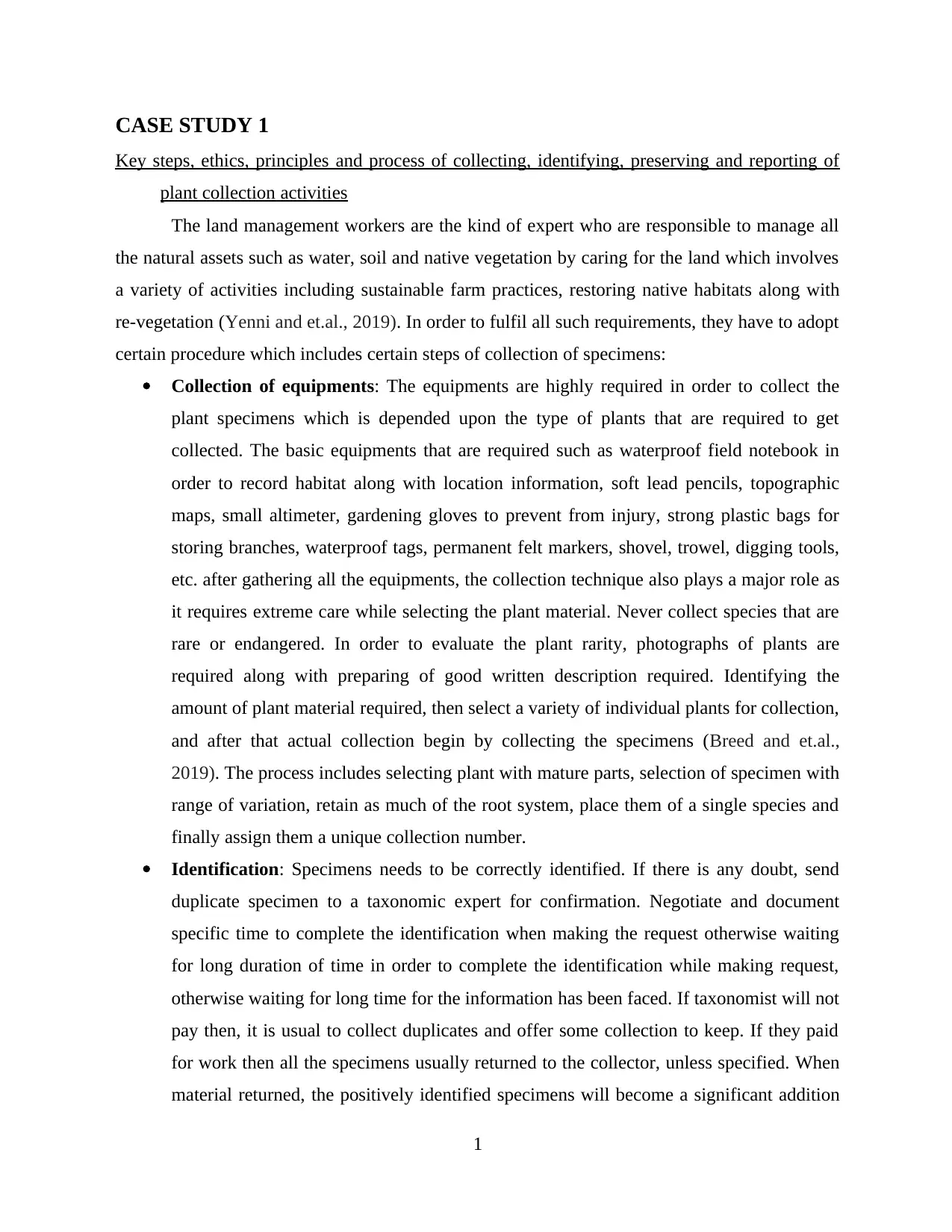
CASE STUDY 1
Key steps, ethics, principles and process of collecting, identifying, preserving and reporting of
plant collection activities
The land management workers are the kind of expert who are responsible to manage all
the natural assets such as water, soil and native vegetation by caring for the land which involves
a variety of activities including sustainable farm practices, restoring native habitats along with
re-vegetation (Yenni and et.al., 2019). In order to fulfil all such requirements, they have to adopt
certain procedure which includes certain steps of collection of specimens:
Collection of equipments: The equipments are highly required in order to collect the
plant specimens which is depended upon the type of plants that are required to get
collected. The basic equipments that are required such as waterproof field notebook in
order to record habitat along with location information, soft lead pencils, topographic
maps, small altimeter, gardening gloves to prevent from injury, strong plastic bags for
storing branches, waterproof tags, permanent felt markers, shovel, trowel, digging tools,
etc. after gathering all the equipments, the collection technique also plays a major role as
it requires extreme care while selecting the plant material. Never collect species that are
rare or endangered. In order to evaluate the plant rarity, photographs of plants are
required along with preparing of good written description required. Identifying the
amount of plant material required, then select a variety of individual plants for collection,
and after that actual collection begin by collecting the specimens (Breed and et.al.,
2019). The process includes selecting plant with mature parts, selection of specimen with
range of variation, retain as much of the root system, place them of a single species and
finally assign them a unique collection number.
Identification: Specimens needs to be correctly identified. If there is any doubt, send
duplicate specimen to a taxonomic expert for confirmation. Negotiate and document
specific time to complete the identification when making the request otherwise waiting
for long duration of time in order to complete the identification while making request,
otherwise waiting for long time for the information has been faced. If taxonomist will not
pay then, it is usual to collect duplicates and offer some collection to keep. If they paid
for work then all the specimens usually returned to the collector, unless specified. When
material returned, the positively identified specimens will become a significant addition
1
Key steps, ethics, principles and process of collecting, identifying, preserving and reporting of
plant collection activities
The land management workers are the kind of expert who are responsible to manage all
the natural assets such as water, soil and native vegetation by caring for the land which involves
a variety of activities including sustainable farm practices, restoring native habitats along with
re-vegetation (Yenni and et.al., 2019). In order to fulfil all such requirements, they have to adopt
certain procedure which includes certain steps of collection of specimens:
Collection of equipments: The equipments are highly required in order to collect the
plant specimens which is depended upon the type of plants that are required to get
collected. The basic equipments that are required such as waterproof field notebook in
order to record habitat along with location information, soft lead pencils, topographic
maps, small altimeter, gardening gloves to prevent from injury, strong plastic bags for
storing branches, waterproof tags, permanent felt markers, shovel, trowel, digging tools,
etc. after gathering all the equipments, the collection technique also plays a major role as
it requires extreme care while selecting the plant material. Never collect species that are
rare or endangered. In order to evaluate the plant rarity, photographs of plants are
required along with preparing of good written description required. Identifying the
amount of plant material required, then select a variety of individual plants for collection,
and after that actual collection begin by collecting the specimens (Breed and et.al.,
2019). The process includes selecting plant with mature parts, selection of specimen with
range of variation, retain as much of the root system, place them of a single species and
finally assign them a unique collection number.
Identification: Specimens needs to be correctly identified. If there is any doubt, send
duplicate specimen to a taxonomic expert for confirmation. Negotiate and document
specific time to complete the identification when making the request otherwise waiting
for long duration of time in order to complete the identification while making request,
otherwise waiting for long time for the information has been faced. If taxonomist will not
pay then, it is usual to collect duplicates and offer some collection to keep. If they paid
for work then all the specimens usually returned to the collector, unless specified. When
material returned, the positively identified specimens will become a significant addition
1
⊘ This is a preview!⊘
Do you want full access?
Subscribe today to unlock all pages.

Trusted by 1+ million students worldwide
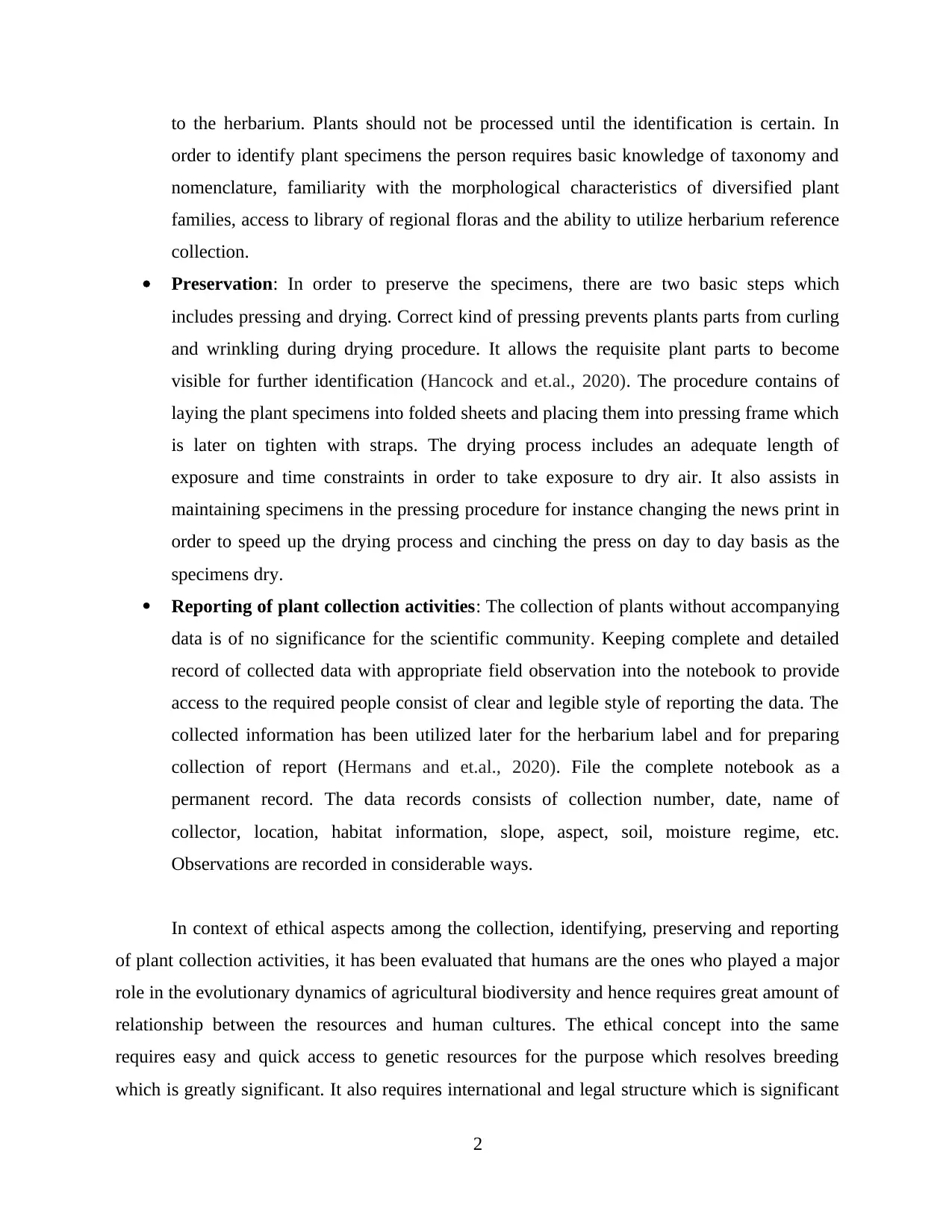
to the herbarium. Plants should not be processed until the identification is certain. In
order to identify plant specimens the person requires basic knowledge of taxonomy and
nomenclature, familiarity with the morphological characteristics of diversified plant
families, access to library of regional floras and the ability to utilize herbarium reference
collection.
Preservation: In order to preserve the specimens, there are two basic steps which
includes pressing and drying. Correct kind of pressing prevents plants parts from curling
and wrinkling during drying procedure. It allows the requisite plant parts to become
visible for further identification (Hancock and et.al., 2020). The procedure contains of
laying the plant specimens into folded sheets and placing them into pressing frame which
is later on tighten with straps. The drying process includes an adequate length of
exposure and time constraints in order to take exposure to dry air. It also assists in
maintaining specimens in the pressing procedure for instance changing the news print in
order to speed up the drying process and cinching the press on day to day basis as the
specimens dry.
Reporting of plant collection activities: The collection of plants without accompanying
data is of no significance for the scientific community. Keeping complete and detailed
record of collected data with appropriate field observation into the notebook to provide
access to the required people consist of clear and legible style of reporting the data. The
collected information has been utilized later for the herbarium label and for preparing
collection of report (Hermans and et.al., 2020). File the complete notebook as a
permanent record. The data records consists of collection number, date, name of
collector, location, habitat information, slope, aspect, soil, moisture regime, etc.
Observations are recorded in considerable ways.
In context of ethical aspects among the collection, identifying, preserving and reporting
of plant collection activities, it has been evaluated that humans are the ones who played a major
role in the evolutionary dynamics of agricultural biodiversity and hence requires great amount of
relationship between the resources and human cultures. The ethical concept into the same
requires easy and quick access to genetic resources for the purpose which resolves breeding
which is greatly significant. It also requires international and legal structure which is significant
2
order to identify plant specimens the person requires basic knowledge of taxonomy and
nomenclature, familiarity with the morphological characteristics of diversified plant
families, access to library of regional floras and the ability to utilize herbarium reference
collection.
Preservation: In order to preserve the specimens, there are two basic steps which
includes pressing and drying. Correct kind of pressing prevents plants parts from curling
and wrinkling during drying procedure. It allows the requisite plant parts to become
visible for further identification (Hancock and et.al., 2020). The procedure contains of
laying the plant specimens into folded sheets and placing them into pressing frame which
is later on tighten with straps. The drying process includes an adequate length of
exposure and time constraints in order to take exposure to dry air. It also assists in
maintaining specimens in the pressing procedure for instance changing the news print in
order to speed up the drying process and cinching the press on day to day basis as the
specimens dry.
Reporting of plant collection activities: The collection of plants without accompanying
data is of no significance for the scientific community. Keeping complete and detailed
record of collected data with appropriate field observation into the notebook to provide
access to the required people consist of clear and legible style of reporting the data. The
collected information has been utilized later for the herbarium label and for preparing
collection of report (Hermans and et.al., 2020). File the complete notebook as a
permanent record. The data records consists of collection number, date, name of
collector, location, habitat information, slope, aspect, soil, moisture regime, etc.
Observations are recorded in considerable ways.
In context of ethical aspects among the collection, identifying, preserving and reporting
of plant collection activities, it has been evaluated that humans are the ones who played a major
role in the evolutionary dynamics of agricultural biodiversity and hence requires great amount of
relationship between the resources and human cultures. The ethical concept into the same
requires easy and quick access to genetic resources for the purpose which resolves breeding
which is greatly significant. It also requires international and legal structure which is significant
2
Paraphrase This Document
Need a fresh take? Get an instant paraphrase of this document with our AI Paraphraser
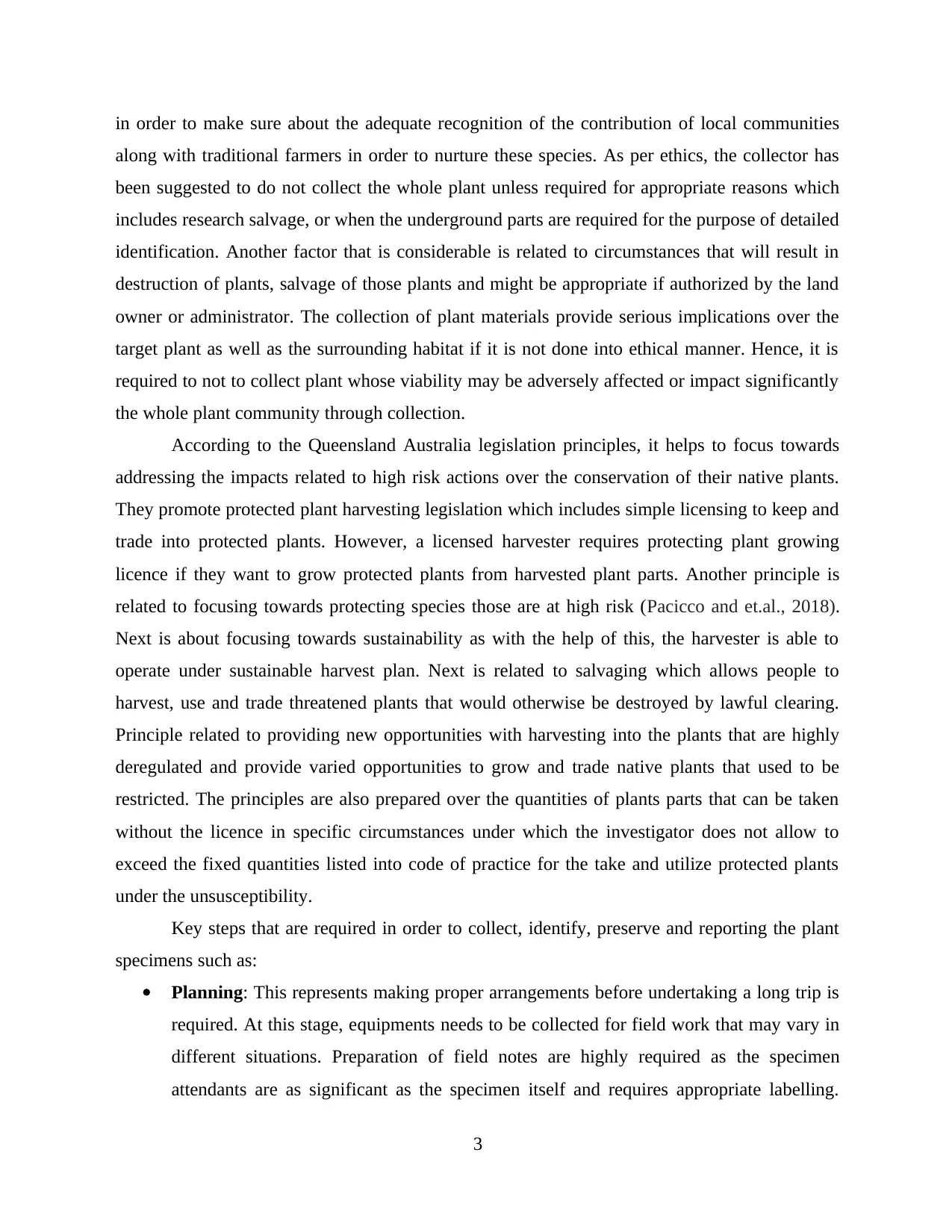
in order to make sure about the adequate recognition of the contribution of local communities
along with traditional farmers in order to nurture these species. As per ethics, the collector has
been suggested to do not collect the whole plant unless required for appropriate reasons which
includes research salvage, or when the underground parts are required for the purpose of detailed
identification. Another factor that is considerable is related to circumstances that will result in
destruction of plants, salvage of those plants and might be appropriate if authorized by the land
owner or administrator. The collection of plant materials provide serious implications over the
target plant as well as the surrounding habitat if it is not done into ethical manner. Hence, it is
required to not to collect plant whose viability may be adversely affected or impact significantly
the whole plant community through collection.
According to the Queensland Australia legislation principles, it helps to focus towards
addressing the impacts related to high risk actions over the conservation of their native plants.
They promote protected plant harvesting legislation which includes simple licensing to keep and
trade into protected plants. However, a licensed harvester requires protecting plant growing
licence if they want to grow protected plants from harvested plant parts. Another principle is
related to focusing towards protecting species those are at high risk (Pacicco and et.al., 2018).
Next is about focusing towards sustainability as with the help of this, the harvester is able to
operate under sustainable harvest plan. Next is related to salvaging which allows people to
harvest, use and trade threatened plants that would otherwise be destroyed by lawful clearing.
Principle related to providing new opportunities with harvesting into the plants that are highly
deregulated and provide varied opportunities to grow and trade native plants that used to be
restricted. The principles are also prepared over the quantities of plants parts that can be taken
without the licence in specific circumstances under which the investigator does not allow to
exceed the fixed quantities listed into code of practice for the take and utilize protected plants
under the unsusceptibility.
Key steps that are required in order to collect, identify, preserve and reporting the plant
specimens such as:
Planning: This represents making proper arrangements before undertaking a long trip is
required. At this stage, equipments needs to be collected for field work that may vary in
different situations. Preparation of field notes are highly required as the specimen
attendants are as significant as the specimen itself and requires appropriate labelling.
3
along with traditional farmers in order to nurture these species. As per ethics, the collector has
been suggested to do not collect the whole plant unless required for appropriate reasons which
includes research salvage, or when the underground parts are required for the purpose of detailed
identification. Another factor that is considerable is related to circumstances that will result in
destruction of plants, salvage of those plants and might be appropriate if authorized by the land
owner or administrator. The collection of plant materials provide serious implications over the
target plant as well as the surrounding habitat if it is not done into ethical manner. Hence, it is
required to not to collect plant whose viability may be adversely affected or impact significantly
the whole plant community through collection.
According to the Queensland Australia legislation principles, it helps to focus towards
addressing the impacts related to high risk actions over the conservation of their native plants.
They promote protected plant harvesting legislation which includes simple licensing to keep and
trade into protected plants. However, a licensed harvester requires protecting plant growing
licence if they want to grow protected plants from harvested plant parts. Another principle is
related to focusing towards protecting species those are at high risk (Pacicco and et.al., 2018).
Next is about focusing towards sustainability as with the help of this, the harvester is able to
operate under sustainable harvest plan. Next is related to salvaging which allows people to
harvest, use and trade threatened plants that would otherwise be destroyed by lawful clearing.
Principle related to providing new opportunities with harvesting into the plants that are highly
deregulated and provide varied opportunities to grow and trade native plants that used to be
restricted. The principles are also prepared over the quantities of plants parts that can be taken
without the licence in specific circumstances under which the investigator does not allow to
exceed the fixed quantities listed into code of practice for the take and utilize protected plants
under the unsusceptibility.
Key steps that are required in order to collect, identify, preserve and reporting the plant
specimens such as:
Planning: This represents making proper arrangements before undertaking a long trip is
required. At this stage, equipments needs to be collected for field work that may vary in
different situations. Preparation of field notes are highly required as the specimen
attendants are as significant as the specimen itself and requires appropriate labelling.
3
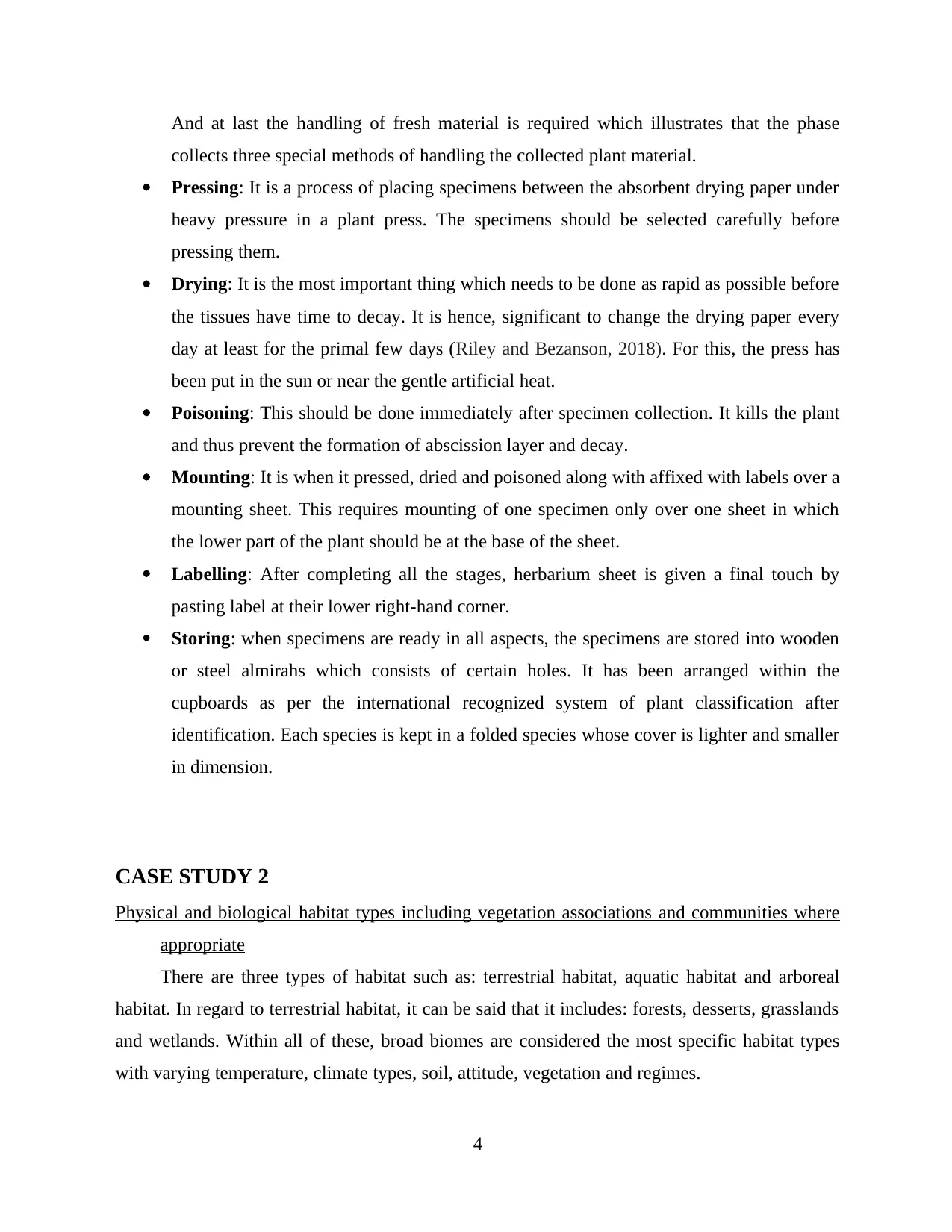
And at last the handling of fresh material is required which illustrates that the phase
collects three special methods of handling the collected plant material.
Pressing: It is a process of placing specimens between the absorbent drying paper under
heavy pressure in a plant press. The specimens should be selected carefully before
pressing them.
Drying: It is the most important thing which needs to be done as rapid as possible before
the tissues have time to decay. It is hence, significant to change the drying paper every
day at least for the primal few days (Riley and Bezanson, 2018). For this, the press has
been put in the sun or near the gentle artificial heat.
Poisoning: This should be done immediately after specimen collection. It kills the plant
and thus prevent the formation of abscission layer and decay.
Mounting: It is when it pressed, dried and poisoned along with affixed with labels over a
mounting sheet. This requires mounting of one specimen only over one sheet in which
the lower part of the plant should be at the base of the sheet.
Labelling: After completing all the stages, herbarium sheet is given a final touch by
pasting label at their lower right-hand corner.
Storing: when specimens are ready in all aspects, the specimens are stored into wooden
or steel almirahs which consists of certain holes. It has been arranged within the
cupboards as per the international recognized system of plant classification after
identification. Each species is kept in a folded species whose cover is lighter and smaller
in dimension.
CASE STUDY 2
Physical and biological habitat types including vegetation associations and communities where
appropriate
There are three types of habitat such as: terrestrial habitat, aquatic habitat and arboreal
habitat. In regard to terrestrial habitat, it can be said that it includes: forests, desserts, grasslands
and wetlands. Within all of these, broad biomes are considered the most specific habitat types
with varying temperature, climate types, soil, attitude, vegetation and regimes.
4
collects three special methods of handling the collected plant material.
Pressing: It is a process of placing specimens between the absorbent drying paper under
heavy pressure in a plant press. The specimens should be selected carefully before
pressing them.
Drying: It is the most important thing which needs to be done as rapid as possible before
the tissues have time to decay. It is hence, significant to change the drying paper every
day at least for the primal few days (Riley and Bezanson, 2018). For this, the press has
been put in the sun or near the gentle artificial heat.
Poisoning: This should be done immediately after specimen collection. It kills the plant
and thus prevent the formation of abscission layer and decay.
Mounting: It is when it pressed, dried and poisoned along with affixed with labels over a
mounting sheet. This requires mounting of one specimen only over one sheet in which
the lower part of the plant should be at the base of the sheet.
Labelling: After completing all the stages, herbarium sheet is given a final touch by
pasting label at their lower right-hand corner.
Storing: when specimens are ready in all aspects, the specimens are stored into wooden
or steel almirahs which consists of certain holes. It has been arranged within the
cupboards as per the international recognized system of plant classification after
identification. Each species is kept in a folded species whose cover is lighter and smaller
in dimension.
CASE STUDY 2
Physical and biological habitat types including vegetation associations and communities where
appropriate
There are three types of habitat such as: terrestrial habitat, aquatic habitat and arboreal
habitat. In regard to terrestrial habitat, it can be said that it includes: forests, desserts, grasslands
and wetlands. Within all of these, broad biomes are considered the most specific habitat types
with varying temperature, climate types, soil, attitude, vegetation and regimes.
4
⊘ This is a preview!⊘
Do you want full access?
Subscribe today to unlock all pages.

Trusted by 1+ million students worldwide
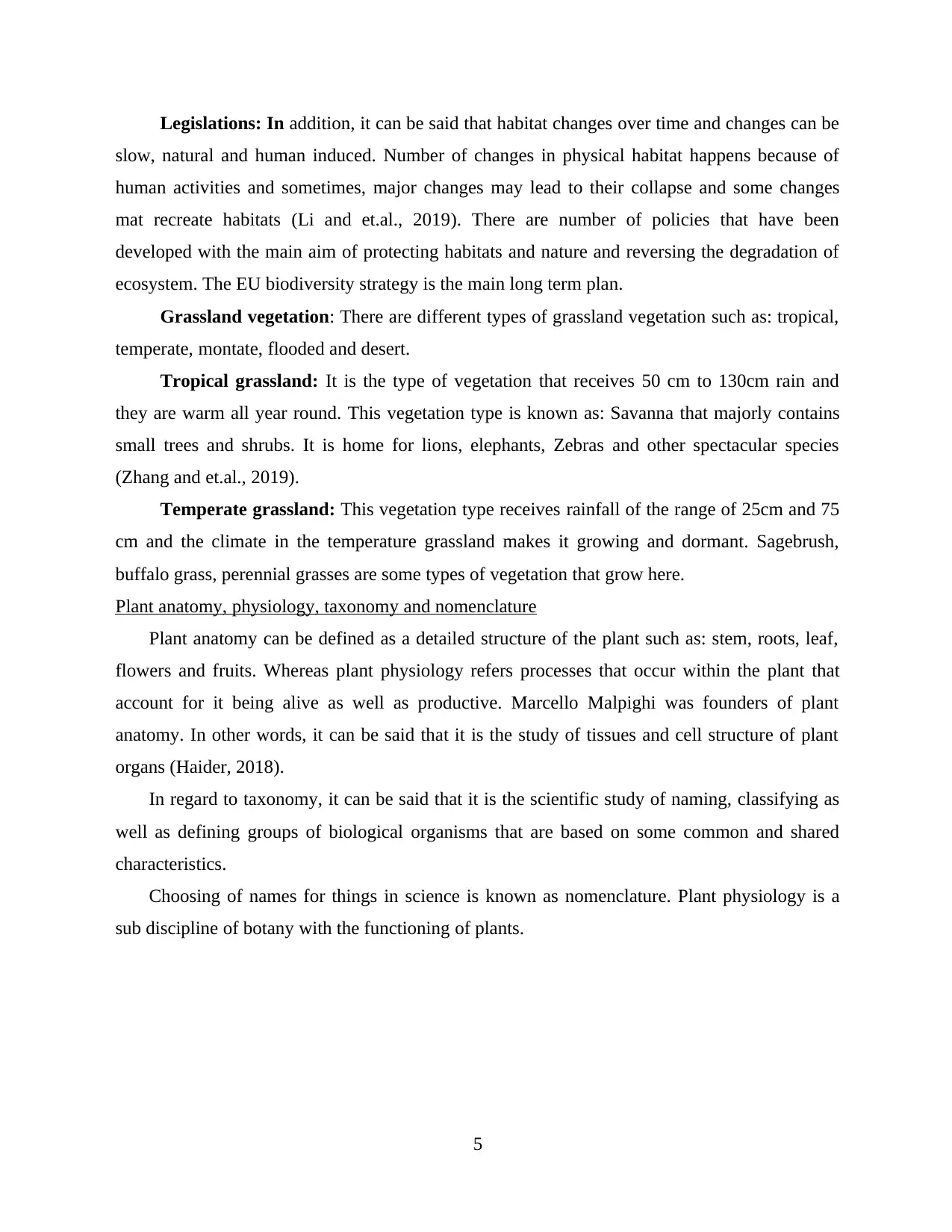
Legislations: In addition, it can be said that habitat changes over time and changes can be
slow, natural and human induced. Number of changes in physical habitat happens because of
human activities and sometimes, major changes may lead to their collapse and some changes
mat recreate habitats (Li and et.al., 2019). There are number of policies that have been
developed with the main aim of protecting habitats and nature and reversing the degradation of
ecosystem. The EU biodiversity strategy is the main long term plan.
Grassland vegetation: There are different types of grassland vegetation such as: tropical,
temperate, montate, flooded and desert.
Tropical grassland: It is the type of vegetation that receives 50 cm to 130cm rain and
they are warm all year round. This vegetation type is known as: Savanna that majorly contains
small trees and shrubs. It is home for lions, elephants, Zebras and other spectacular species
(Zhang and et.al., 2019).
Temperate grassland: This vegetation type receives rainfall of the range of 25cm and 75
cm and the climate in the temperature grassland makes it growing and dormant. Sagebrush,
buffalo grass, perennial grasses are some types of vegetation that grow here.
Plant anatomy, physiology, taxonomy and nomenclature
Plant anatomy can be defined as a detailed structure of the plant such as: stem, roots, leaf,
flowers and fruits. Whereas plant physiology refers processes that occur within the plant that
account for it being alive as well as productive. Marcello Malpighi was founders of plant
anatomy. In other words, it can be said that it is the study of tissues and cell structure of plant
organs (Haider, 2018).
In regard to taxonomy, it can be said that it is the scientific study of naming, classifying as
well as defining groups of biological organisms that are based on some common and shared
characteristics.
Choosing of names for things in science is known as nomenclature. Plant physiology is a
sub discipline of botany with the functioning of plants.
5
slow, natural and human induced. Number of changes in physical habitat happens because of
human activities and sometimes, major changes may lead to their collapse and some changes
mat recreate habitats (Li and et.al., 2019). There are number of policies that have been
developed with the main aim of protecting habitats and nature and reversing the degradation of
ecosystem. The EU biodiversity strategy is the main long term plan.
Grassland vegetation: There are different types of grassland vegetation such as: tropical,
temperate, montate, flooded and desert.
Tropical grassland: It is the type of vegetation that receives 50 cm to 130cm rain and
they are warm all year round. This vegetation type is known as: Savanna that majorly contains
small trees and shrubs. It is home for lions, elephants, Zebras and other spectacular species
(Zhang and et.al., 2019).
Temperate grassland: This vegetation type receives rainfall of the range of 25cm and 75
cm and the climate in the temperature grassland makes it growing and dormant. Sagebrush,
buffalo grass, perennial grasses are some types of vegetation that grow here.
Plant anatomy, physiology, taxonomy and nomenclature
Plant anatomy can be defined as a detailed structure of the plant such as: stem, roots, leaf,
flowers and fruits. Whereas plant physiology refers processes that occur within the plant that
account for it being alive as well as productive. Marcello Malpighi was founders of plant
anatomy. In other words, it can be said that it is the study of tissues and cell structure of plant
organs (Haider, 2018).
In regard to taxonomy, it can be said that it is the scientific study of naming, classifying as
well as defining groups of biological organisms that are based on some common and shared
characteristics.
Choosing of names for things in science is known as nomenclature. Plant physiology is a
sub discipline of botany with the functioning of plants.
5
Paraphrase This Document
Need a fresh take? Get an instant paraphrase of this document with our AI Paraphraser
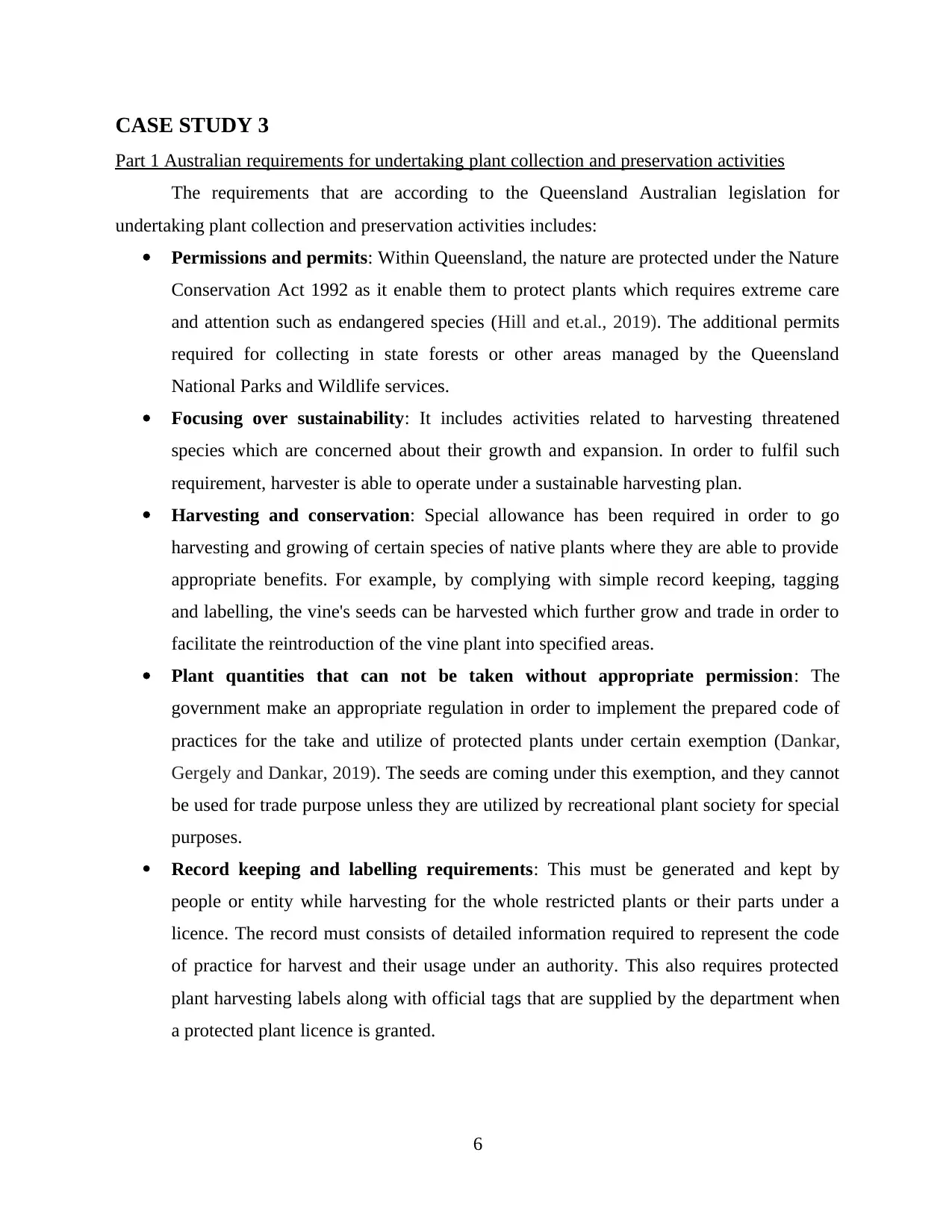
CASE STUDY 3
Part 1 Australian requirements for undertaking plant collection and preservation activities
The requirements that are according to the Queensland Australian legislation for
undertaking plant collection and preservation activities includes:
Permissions and permits: Within Queensland, the nature are protected under the Nature
Conservation Act 1992 as it enable them to protect plants which requires extreme care
and attention such as endangered species (Hill and et.al., 2019). The additional permits
required for collecting in state forests or other areas managed by the Queensland
National Parks and Wildlife services.
Focusing over sustainability: It includes activities related to harvesting threatened
species which are concerned about their growth and expansion. In order to fulfil such
requirement, harvester is able to operate under a sustainable harvesting plan.
Harvesting and conservation: Special allowance has been required in order to go
harvesting and growing of certain species of native plants where they are able to provide
appropriate benefits. For example, by complying with simple record keeping, tagging
and labelling, the vine's seeds can be harvested which further grow and trade in order to
facilitate the reintroduction of the vine plant into specified areas.
Plant quantities that can not be taken without appropriate permission: The
government make an appropriate regulation in order to implement the prepared code of
practices for the take and utilize of protected plants under certain exemption (Dankar,
Gergely and Dankar, 2019). The seeds are coming under this exemption, and they cannot
be used for trade purpose unless they are utilized by recreational plant society for special
purposes.
Record keeping and labelling requirements: This must be generated and kept by
people or entity while harvesting for the whole restricted plants or their parts under a
licence. The record must consists of detailed information required to represent the code
of practice for harvest and their usage under an authority. This also requires protected
plant harvesting labels along with official tags that are supplied by the department when
a protected plant licence is granted.
6
Part 1 Australian requirements for undertaking plant collection and preservation activities
The requirements that are according to the Queensland Australian legislation for
undertaking plant collection and preservation activities includes:
Permissions and permits: Within Queensland, the nature are protected under the Nature
Conservation Act 1992 as it enable them to protect plants which requires extreme care
and attention such as endangered species (Hill and et.al., 2019). The additional permits
required for collecting in state forests or other areas managed by the Queensland
National Parks and Wildlife services.
Focusing over sustainability: It includes activities related to harvesting threatened
species which are concerned about their growth and expansion. In order to fulfil such
requirement, harvester is able to operate under a sustainable harvesting plan.
Harvesting and conservation: Special allowance has been required in order to go
harvesting and growing of certain species of native plants where they are able to provide
appropriate benefits. For example, by complying with simple record keeping, tagging
and labelling, the vine's seeds can be harvested which further grow and trade in order to
facilitate the reintroduction of the vine plant into specified areas.
Plant quantities that can not be taken without appropriate permission: The
government make an appropriate regulation in order to implement the prepared code of
practices for the take and utilize of protected plants under certain exemption (Dankar,
Gergely and Dankar, 2019). The seeds are coming under this exemption, and they cannot
be used for trade purpose unless they are utilized by recreational plant society for special
purposes.
Record keeping and labelling requirements: This must be generated and kept by
people or entity while harvesting for the whole restricted plants or their parts under a
licence. The record must consists of detailed information required to represent the code
of practice for harvest and their usage under an authority. This also requires protected
plant harvesting labels along with official tags that are supplied by the department when
a protected plant licence is granted.
6

Part 2 Plant collection procedure
There are some steps that need to be followed for plant collection such as:
Planning, pressing, drying, poisoning, mounting, labelling and storing. A voucher herbarium
specimen is a pressed plant sample with collection data with some steps such as:
Initial preparation: In this preparation, a person who is going to collect plant, needs to
target collection locations and date periods with the main aim of obtaining useful specimen
(Villacorta-Rath and Burrows, 2021). After that this, they need to obtain collection permits,
establish contracts, make arrangements and purchasing collecting equipments.
Pressing and drying: Specimen samples are pressed in a plant press and dried on a plant
dryer.
Label: A plant specimen is incomplete without label data. Some scientific names that
can be given to plants include: genus, species, authority and intraspecific information.
Plant collection risk assessment tool
Plant risk evaluator is known as an effective risk assessment tool that is being used while
collection of plant. It is a 20 question plant risk assessment tool. This online platform allows,
specimen to know all about terrestrial plant production before they grow. By doing so, they can
protect themselves from potential regional invasive risk (Ghasemidehkordi and et.al., 2018).
Plant identification tool template
Plant identification tool sample consists of:
Plant form
Plant size
Location as where the plant is growing
Site characteristics and bark characteristics.
Tools selection is being done after evaluating all these things as it can help out Specimen in
selecting defectiveness tool and protecting themselves against risks (Barone and et.al., 2020).
7
There are some steps that need to be followed for plant collection such as:
Planning, pressing, drying, poisoning, mounting, labelling and storing. A voucher herbarium
specimen is a pressed plant sample with collection data with some steps such as:
Initial preparation: In this preparation, a person who is going to collect plant, needs to
target collection locations and date periods with the main aim of obtaining useful specimen
(Villacorta-Rath and Burrows, 2021). After that this, they need to obtain collection permits,
establish contracts, make arrangements and purchasing collecting equipments.
Pressing and drying: Specimen samples are pressed in a plant press and dried on a plant
dryer.
Label: A plant specimen is incomplete without label data. Some scientific names that
can be given to plants include: genus, species, authority and intraspecific information.
Plant collection risk assessment tool
Plant risk evaluator is known as an effective risk assessment tool that is being used while
collection of plant. It is a 20 question plant risk assessment tool. This online platform allows,
specimen to know all about terrestrial plant production before they grow. By doing so, they can
protect themselves from potential regional invasive risk (Ghasemidehkordi and et.al., 2018).
Plant identification tool template
Plant identification tool sample consists of:
Plant form
Plant size
Location as where the plant is growing
Site characteristics and bark characteristics.
Tools selection is being done after evaluating all these things as it can help out Specimen in
selecting defectiveness tool and protecting themselves against risks (Barone and et.al., 2020).
7
⊘ This is a preview!⊘
Do you want full access?
Subscribe today to unlock all pages.

Trusted by 1+ million students worldwide
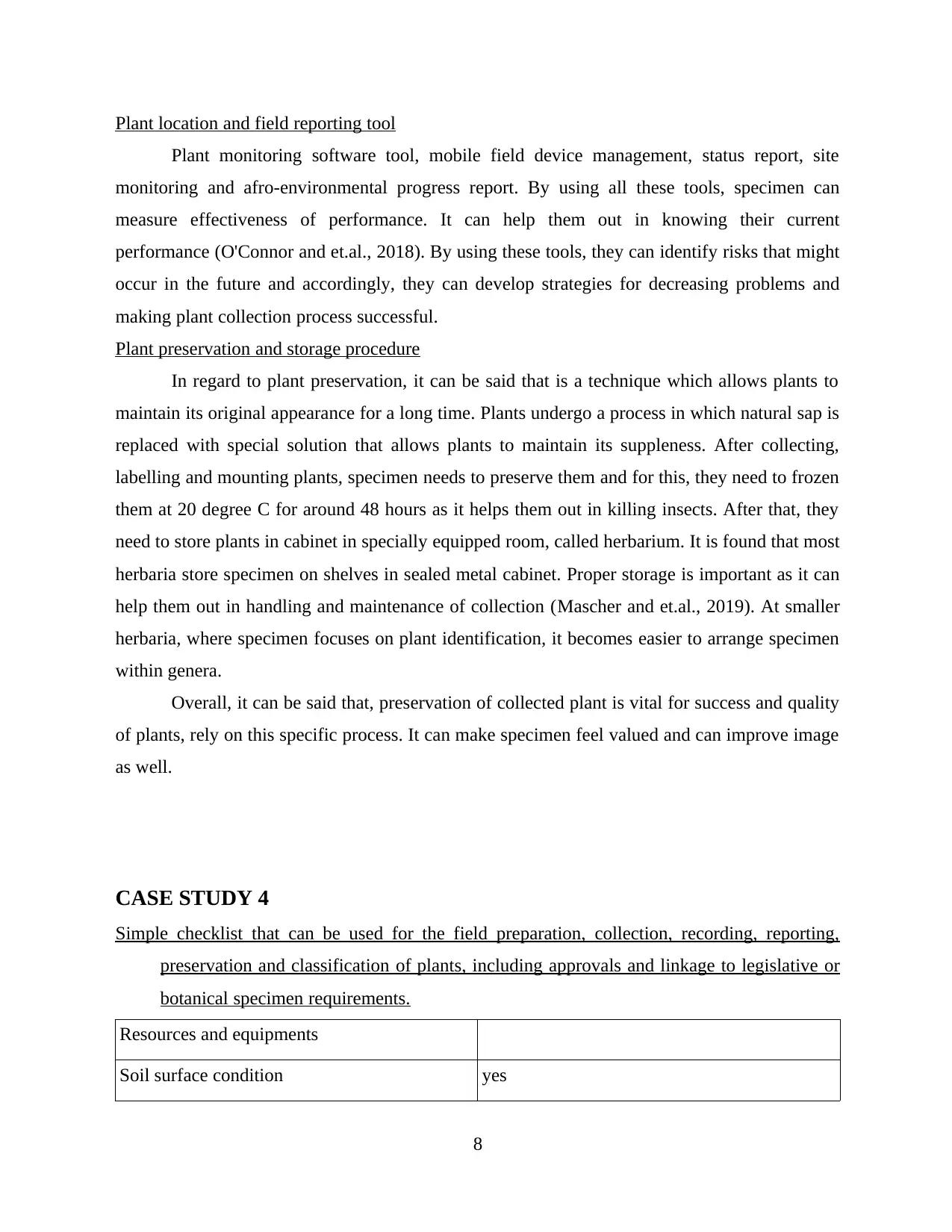
Plant location and field reporting tool
Plant monitoring software tool, mobile field device management, status report, site
monitoring and afro-environmental progress report. By using all these tools, specimen can
measure effectiveness of performance. It can help them out in knowing their current
performance (O'Connor and et.al., 2018). By using these tools, they can identify risks that might
occur in the future and accordingly, they can develop strategies for decreasing problems and
making plant collection process successful.
Plant preservation and storage procedure
In regard to plant preservation, it can be said that is a technique which allows plants to
maintain its original appearance for a long time. Plants undergo a process in which natural sap is
replaced with special solution that allows plants to maintain its suppleness. After collecting,
labelling and mounting plants, specimen needs to preserve them and for this, they need to frozen
them at 20 degree C for around 48 hours as it helps them out in killing insects. After that, they
need to store plants in cabinet in specially equipped room, called herbarium. It is found that most
herbaria store specimen on shelves in sealed metal cabinet. Proper storage is important as it can
help them out in handling and maintenance of collection (Mascher and et.al., 2019). At smaller
herbaria, where specimen focuses on plant identification, it becomes easier to arrange specimen
within genera.
Overall, it can be said that, preservation of collected plant is vital for success and quality
of plants, rely on this specific process. It can make specimen feel valued and can improve image
as well.
CASE STUDY 4
Simple checklist that can be used for the field preparation, collection, recording, reporting,
preservation and classification of plants, including approvals and linkage to legislative or
botanical specimen requirements.
Resources and equipments
Soil surface condition yes
8
Plant monitoring software tool, mobile field device management, status report, site
monitoring and afro-environmental progress report. By using all these tools, specimen can
measure effectiveness of performance. It can help them out in knowing their current
performance (O'Connor and et.al., 2018). By using these tools, they can identify risks that might
occur in the future and accordingly, they can develop strategies for decreasing problems and
making plant collection process successful.
Plant preservation and storage procedure
In regard to plant preservation, it can be said that is a technique which allows plants to
maintain its original appearance for a long time. Plants undergo a process in which natural sap is
replaced with special solution that allows plants to maintain its suppleness. After collecting,
labelling and mounting plants, specimen needs to preserve them and for this, they need to frozen
them at 20 degree C for around 48 hours as it helps them out in killing insects. After that, they
need to store plants in cabinet in specially equipped room, called herbarium. It is found that most
herbaria store specimen on shelves in sealed metal cabinet. Proper storage is important as it can
help them out in handling and maintenance of collection (Mascher and et.al., 2019). At smaller
herbaria, where specimen focuses on plant identification, it becomes easier to arrange specimen
within genera.
Overall, it can be said that, preservation of collected plant is vital for success and quality
of plants, rely on this specific process. It can make specimen feel valued and can improve image
as well.
CASE STUDY 4
Simple checklist that can be used for the field preparation, collection, recording, reporting,
preservation and classification of plants, including approvals and linkage to legislative or
botanical specimen requirements.
Resources and equipments
Soil surface condition yes
8
Paraphrase This Document
Need a fresh take? Get an instant paraphrase of this document with our AI Paraphraser

Storage devices yes
Vegetative materials
Collection number
Associated species
9
Vegetative materials
Collection number
Associated species
9
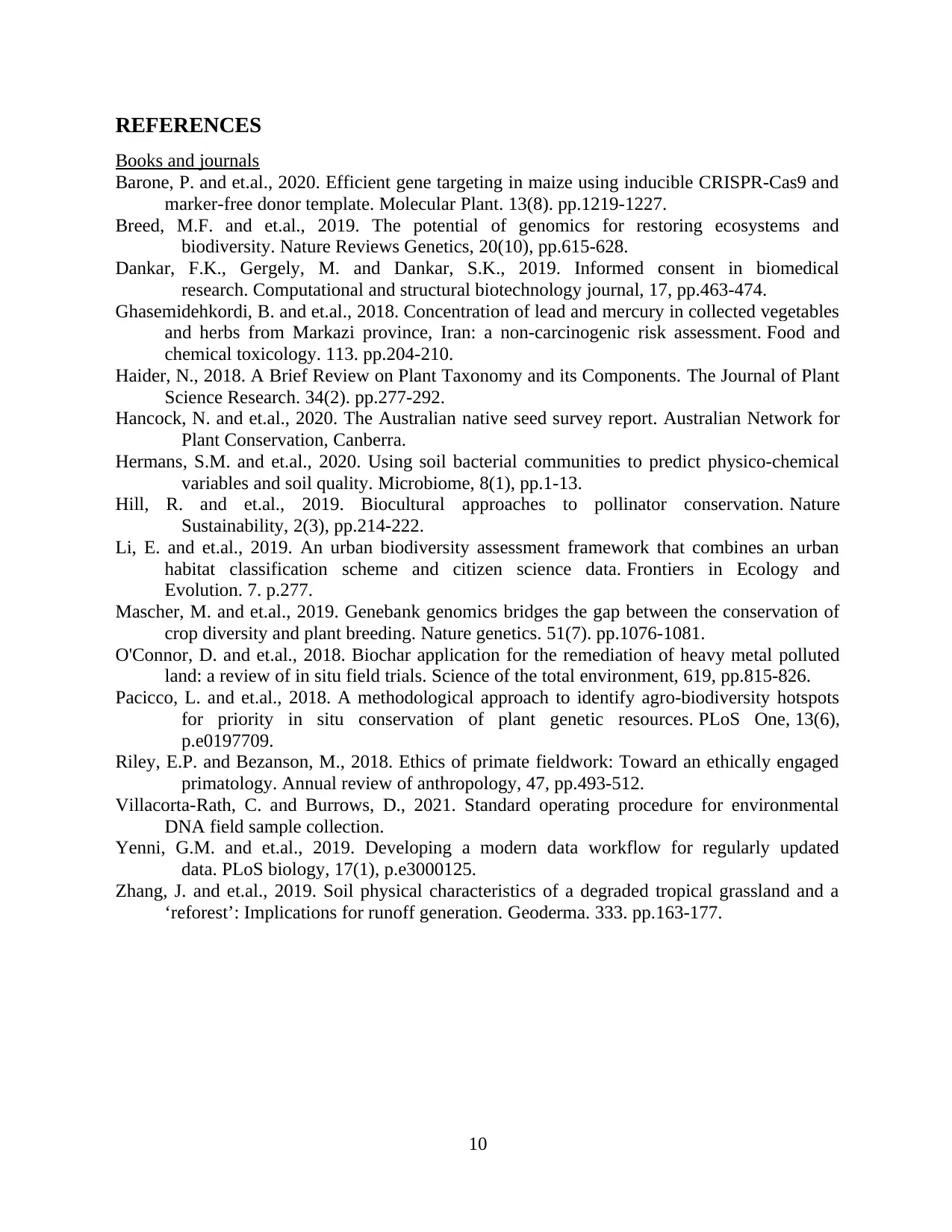
REFERENCES
Books and journals
Barone, P. and et.al., 2020. Efficient gene targeting in maize using inducible CRISPR-Cas9 and
marker-free donor template. Molecular Plant. 13(8). pp.1219-1227.
Breed, M.F. and et.al., 2019. The potential of genomics for restoring ecosystems and
biodiversity. Nature Reviews Genetics, 20(10), pp.615-628.
Dankar, F.K., Gergely, M. and Dankar, S.K., 2019. Informed consent in biomedical
research. Computational and structural biotechnology journal, 17, pp.463-474.
Ghasemidehkordi, B. and et.al., 2018. Concentration of lead and mercury in collected vegetables
and herbs from Markazi province, Iran: a non-carcinogenic risk assessment. Food and
chemical toxicology. 113. pp.204-210.
Haider, N., 2018. A Brief Review on Plant Taxonomy and its Components. The Journal of Plant
Science Research. 34(2). pp.277-292.
Hancock, N. and et.al., 2020. The Australian native seed survey report. Australian Network for
Plant Conservation, Canberra.
Hermans, S.M. and et.al., 2020. Using soil bacterial communities to predict physico-chemical
variables and soil quality. Microbiome, 8(1), pp.1-13.
Hill, R. and et.al., 2019. Biocultural approaches to pollinator conservation. Nature
Sustainability, 2(3), pp.214-222.
Li, E. and et.al., 2019. An urban biodiversity assessment framework that combines an urban
habitat classification scheme and citizen science data. Frontiers in Ecology and
Evolution. 7. p.277.
Mascher, M. and et.al., 2019. Genebank genomics bridges the gap between the conservation of
crop diversity and plant breeding. Nature genetics. 51(7). pp.1076-1081.
O'Connor, D. and et.al., 2018. Biochar application for the remediation of heavy metal polluted
land: a review of in situ field trials. Science of the total environment, 619, pp.815-826.
Pacicco, L. and et.al., 2018. A methodological approach to identify agro-biodiversity hotspots
for priority in situ conservation of plant genetic resources. PLoS One, 13(6),
p.e0197709.
Riley, E.P. and Bezanson, M., 2018. Ethics of primate fieldwork: Toward an ethically engaged
primatology. Annual review of anthropology, 47, pp.493-512.
Villacorta-Rath, C. and Burrows, D., 2021. Standard operating procedure for environmental
DNA field sample collection.
Yenni, G.M. and et.al., 2019. Developing a modern data workflow for regularly updated
data. PLoS biology, 17(1), p.e3000125.
Zhang, J. and et.al., 2019. Soil physical characteristics of a degraded tropical grassland and a
‘reforest’: Implications for runoff generation. Geoderma. 333. pp.163-177.
10
Books and journals
Barone, P. and et.al., 2020. Efficient gene targeting in maize using inducible CRISPR-Cas9 and
marker-free donor template. Molecular Plant. 13(8). pp.1219-1227.
Breed, M.F. and et.al., 2019. The potential of genomics for restoring ecosystems and
biodiversity. Nature Reviews Genetics, 20(10), pp.615-628.
Dankar, F.K., Gergely, M. and Dankar, S.K., 2019. Informed consent in biomedical
research. Computational and structural biotechnology journal, 17, pp.463-474.
Ghasemidehkordi, B. and et.al., 2018. Concentration of lead and mercury in collected vegetables
and herbs from Markazi province, Iran: a non-carcinogenic risk assessment. Food and
chemical toxicology. 113. pp.204-210.
Haider, N., 2018. A Brief Review on Plant Taxonomy and its Components. The Journal of Plant
Science Research. 34(2). pp.277-292.
Hancock, N. and et.al., 2020. The Australian native seed survey report. Australian Network for
Plant Conservation, Canberra.
Hermans, S.M. and et.al., 2020. Using soil bacterial communities to predict physico-chemical
variables and soil quality. Microbiome, 8(1), pp.1-13.
Hill, R. and et.al., 2019. Biocultural approaches to pollinator conservation. Nature
Sustainability, 2(3), pp.214-222.
Li, E. and et.al., 2019. An urban biodiversity assessment framework that combines an urban
habitat classification scheme and citizen science data. Frontiers in Ecology and
Evolution. 7. p.277.
Mascher, M. and et.al., 2019. Genebank genomics bridges the gap between the conservation of
crop diversity and plant breeding. Nature genetics. 51(7). pp.1076-1081.
O'Connor, D. and et.al., 2018. Biochar application for the remediation of heavy metal polluted
land: a review of in situ field trials. Science of the total environment, 619, pp.815-826.
Pacicco, L. and et.al., 2018. A methodological approach to identify agro-biodiversity hotspots
for priority in situ conservation of plant genetic resources. PLoS One, 13(6),
p.e0197709.
Riley, E.P. and Bezanson, M., 2018. Ethics of primate fieldwork: Toward an ethically engaged
primatology. Annual review of anthropology, 47, pp.493-512.
Villacorta-Rath, C. and Burrows, D., 2021. Standard operating procedure for environmental
DNA field sample collection.
Yenni, G.M. and et.al., 2019. Developing a modern data workflow for regularly updated
data. PLoS biology, 17(1), p.e3000125.
Zhang, J. and et.al., 2019. Soil physical characteristics of a degraded tropical grassland and a
‘reforest’: Implications for runoff generation. Geoderma. 333. pp.163-177.
10
⊘ This is a preview!⊘
Do you want full access?
Subscribe today to unlock all pages.

Trusted by 1+ million students worldwide
1 out of 12
Your All-in-One AI-Powered Toolkit for Academic Success.
+13062052269
info@desklib.com
Available 24*7 on WhatsApp / Email
![[object Object]](/_next/static/media/star-bottom.7253800d.svg)
Unlock your academic potential
Copyright © 2020–2025 A2Z Services. All Rights Reserved. Developed and managed by ZUCOL.


